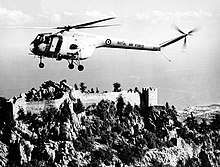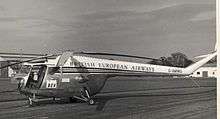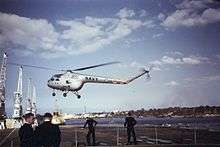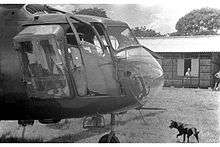Bristol Sycamore
| Type 171 Sycamore | |
|---|---|
 | |
| Bristol 171 Sycamore in Ansett-ANA service in Australia around 1960, used for crop dusting. This one example proved to be too costly to operate and crashed in 1961. | |
| Role | Rescue and Anti-Submarine Helicopter |
| National origin | United Kingdom |
| Manufacturer | Bristol Aeroplane Company |
| Designer | Raoul Hafner |
| First flight | 27 July 1947 |
| Introduction | 1953 |
| Primary users | Royal Air Force Royal Australian Navy German Army |
| Produced | 1947–1959[1] |
| Number built | 180[1] |
The Bristol Type 171 Sycamore was an early helicopter developed and built by the helicopter division of the Bristol Aeroplane Company. The name refers to the seeds of the Sycamore tree, Acer pseudoplatanus, which fall with a rotating motion.[2] It has the distinction of being the first British helicopter to receive a certificate of airworthiness, as well as being the first British-designed helicopter to be introduced by and to serve with the Royal Air Force (RAF).[2]
Typically capable of seating up to three passengers, the type was often used as a transport for both passengers and cargo alike. In RAF service, the Sycamore was normally used in the search and rescue and casualty evacuation roles. The type proved the value of rotorcraft to easily traverse inhospitable or otherwise inaccessible terrain; the Sycamore made valuable contributions to British military activities during the Malayan Emergency, the Cyprus Emergency, and the Aden Emergency, in addition to other operations.
In addition to its British military service, various models of the Sycamore were produced and operated by a number of users, including overseas military operations and civil customers. Civilian operations typically involved transportation, mountain rescue, and aerial survey work. In 1959, production of the Sycamore ended after 180 rotorcraft had been completed.[1]
Development
During the Second World War, new methods of aircraft propulsion were devised and experimented with; in particular, breakthroughs in rotary aircraft, such as gyrocopters and helicopters, were making such aircraft more practical.[2] In 1944, Bristol established a specialised helicopter division shortly after the Allied invasion of Europe, when engineers from the Airborne Forces Experimental Establishment (AFEE) at Beaulieu became available. The AFEE had been conducting its own work on the development of rotorcraft designs under the noted helicopter pioneer Raoul Hafner; however, the successful use of Horsa and Hamilcar gliders during Operation Overlord had led to helicopter development being recognised as a priority. Hafner, whose company had been acquired by Bristol was promptly appointed by the company as the head of Bristol's new helicopter division.[3][1][2]
In June 1944, work commenced on the development on a four-seat helicopter intended for both civil and military use; it was out of this programme that the Sycamore would emerge.[1] During development, particular emphasis was assigned to the producing the necessary level of endurance of the rotorcraft's mechanical components. On 25 July 1947, the first prototype, VL958, which was powered by a 450-horsepower (340 kW) Pratt & Whitney Wasp Junior (there being no suitable engine in the Bristol range), performed the type's maiden flight.[1][2] In mid-1948, the third prototype, which had been built to the improved Sycamore Mk.2 standard, was completed; this model had been fitted with a 550-horsepower (410 kW) Alvis Leonides engine, the Leonides engine would become the standard powerplant for all subsequent Sycamore production. On 25 April 1949, a certificate of airworthiness was granted for the Sycamore, the first such to be granted to a British helicopter.[1][2]
During the flight test programme, Bristol's key development pilots for the Type 171 included Charles "Sox" Hosegood and Col. Robert "Bob" Smith. In 1951, a Bristol-owned Sycamore Mk.2 was used during a series of deck landing trials performed on board the Royal Navy aircraft carrier HMS Triumph.[4] An improved model of the helicopter, designated as the Sycamore Mk.3, was rapidly developed; it featured an increased capacity for five occupants, a wider fuselage and a shortened nose.[2] A total of 23 Sycamore Mk.3s were produced, 15 of these were principally used for joint evaluation purposes by the Royal Air Force (RAF), Army Air Corps (AAC), and British European Airways (BEA).[1][2]
Versions of the Sycamore up to and including the Mk.3A retained the standard two-seat cockpit layout, placing the pilot in the left-hand seat and the co-pilot in the right.[2] However, on the main production model, designated as the Sycamore Mk.4, this seating arrangement had been switched to the standard American practice of positioning the pilot's seat on the right. There were also a number of other developments that had featured upon the earlier versions, such as a four-door design, which had been standardised upon the Sycamore Mk.4. This version entered RAF service, receiving the military designation of HR14.[2]
Civil versions were not marketed under the Sycamore name, they were instead known simply as the Bristol Type 171.[2] By May 1958, over 150 Sycamores had been manufactured and four units per month were being built.[5]
Design

The Bristol Sycamore is one of the first production helicopters to be developed.[5] Each Sycamore was manufactured with all of the necessary fixed fittings to enable it to be quickly adapted between configurations to perform any of six major roles: search and rescue, air ambulance, passenger transport, freight transport, aerial crane and dual instruction; it was also used for other specialised roles.[5] The Sycamore is capable of seating four-to-five occupants, dependent upon model, within the main cabin; it was typically outfitted with a total of three folding canvas seats along with a single rotating seat besides the pilot. In addition to the main cabin, it also has a separate luggage compartment.[5]
A specialised air ambulance model of the Sycamore was developed during the early 1950s. In this configuration, up to two patients were internally-stowed on stretchers stacked one over the other in the cabin; this was contrary to the conventional arrangement of the era of using externally-mounted "pods" in which to carry patients instead.[6] To provide the extra width necessary to accommodate this arrangement, detachable Perspex blisters are fitted on each side of the cabin. The stretcher racks could be folded into the sides of the cabin, providing room for up to three sitting casualties instead; a purpose-built electrical point is also provided for powering electric blankets. Adjacent to the pilot is a swivelling seat intended for a medical attendant.[6]
The blades of the three-bladed main rotor are attached to the rotor head via a lightweight and strong interleaving steel plates while tie-rods absorb direct centrifugal force under tension.[5] The blade levers are connected via ball joints to the arms of a control spider, the cone of which being actuated up and down by the collective pitch lever in order to change to pitch of all of the blades; an irreversible mechanism is present to prevent blade loads being transferred back to the control stick. The blades are supported when still or at slow rotational speeds by droop stops, which serve to keep a level of clearance between the blades and the fuselage even under high wind conditions; these stops are withdrawn above 100 RPM so that full freedom of movement for effective flight is possible.[7]
The Sycamore is powered by a single Alvis Leonides piston engine, capable of outputting 550 hp.[8] The engine is mounted on below and to the rear of the main rotor on a flexible mounting in order to reduce vibrations. It is isolated within a fireproof casing, the compartment is also fitted with fire extinguishing equipment that conformed with the relevant regulations of the era.[8] Cooling is achieved via air drawn through a forward-set grill, actively cooling the gearbox prior to passing through the engine cowling and exiting the fuselage. Control of the engine is linked to the collective pitch lever, power being automatically controlled by the rotor pitch setting being commanded; fine adjustment of engine power is achieved via twisting actions on the pitch handle lever.[8] The Sycamore had a relatively high rotor speed for the era, which was claimed to deliver increased smoothness during flight and provide for a safety advantage in the event of engine failure.[8]
Operational history

In April 1953, the Sycamore HR14 entered service with 275 Squadron of the RAF; and went on to serve with nine squadrons in total. Various marks of the Sycamores were inducted into RAF service; they would primarily be used as Air Ambulances (Sycamore HC.10), Army communications (Sycamore HC.11) and for Search and Rescue operations (Sycamore HR.12 through the Sycamore HR.14).[2] In 1953, No. 275 Squadron, equipped with Sycamores, became the RAF’s first helicopter search and rescue squadron in Great Britain.[9] The type was used by the Royal Air Force Central Flying School for pilot training purposes.[9]
The Sycamore was heavily used during the Malayan Emergency (1948–1960), typically deploying Army foot patrols into the jungle. Numerous Sycamores were transferred to the Far East Air Force to participate in the conflict; however, the type was involved in a number of crashes in the region which had occurred as a result of tail or main rotor blade problems.[9][10] In response, a series of blade trials were conducted prior to a modified blade design being adopted and Sycamore operations in the theater being resumed. Following the end of most combat operations in August 1960, Sycamores remained in the region, including a detachment in Brunei, to support British forces stationed there to deter further aggression by Malayan communist guerillas.[9]

The type also saw combat service with the RAF during the Cyprus Emergency and the Aden Emergency, in addition to other operations. In December 1971, the last of the RAF's Sycamores were officially retired; this had been due to critical parts having reached the end of their fatigue life. However 32 Squadron continued to operate two Sycamores until August 1972.[9][2]
A total of 50 Sycamores were delivered to the German Federal Government.[2] Three helicopters were produced for the Belgian Government for use in the Belgian Congo; it had been picked due to the type's good capabilities in tropical environments, as proven during its combat use in Malaysia.[11] The Sycamore also has the distinction of being the second helicopter type to be used by the Australian Defence Force; a total of 10 were delivered to the Royal Australian Navy.[2]
The Sycamore was also used in a variety of civilian roles. A single example was used during the construction of the M1 motorway between London and Leeds; the type provided support in various roles, including to perform aerial surveying, communication across various sites, the carriage of both personnel and equipment, and the mitigation of flooding on the project.[12] Sycamores operated by Australian National Airways were routinely available for charter, performing tasks such as the aerial surveying of mining claims, supply missions, and the transporting of equipment across the remote Outback areas of the nation.[13]
Variants
Type 171
- Mk 1
- Prototype; two built.[2]
- Mk 2
- Second prototype; one built.[2]
- Mk 3
- Production model with five seats in a widened fuselages and a shortened nose to improve visibility. Fifteen built.[2]
- Mk 3A
- Civilian version with additional freight hold, two built for British European Airways.[2]
- Mk 4
- This was the main production model and similar to the military version called Sycamore with a more powerful engine.[2]
Sycamore
- Sycamore HC10
- (=Mk.3) one built for evaluation by the Army Air Corps as an air ambulance.[2]
- Sycamore HC11
- (=Mk.3) four built for evaluation by the Army Air Corps, as communications aircraft.[2]
- Sycamore HR12
- (=Mk.3A) four built for the RAF for evaluation as search and rescue aircraft.[2]
- Sycamore HR13
- (=Mk.3A) two built with rescue winches for the RAF for evaluation as search and rescue aircraft.[2]
- Sycamore HR14
- (=Mk.4) 85 built for the RAF, as search and rescue aircraft.[2]
- Sycamore Mk 14
- three built for the Belgian Air Force, for use in the Belgian Congo.[2]
- Sycamore Mk 50
- three built for the Royal Australian Navy, for search and rescue, and plane guard duties.[2]
- Sycamore HC51
- seven built for the Royal Australian Navy, for search and rescue, and plane guard duties.[2]
- Sycamore Mk 52
- 50 built for the German Army and Navy.[2]
Operators
Civil operators

- Australian National Airways/Ansett-ANA
- Jayrow Helicopters
- Flying Bulls In 2013 the Flying Bulls by Red Bull reinstated one Sycamore
Military operators

- Royal Australian Air Force – Only two Sycamores were in service with the RAAF from 1951 to 1965. The two helicopters were used for general support duties at the Woomera Rocket Range in South Australia.
- Aircraft Research and Development Unit
- No. 1 Air Trials unit
- Royal Australian Navy
- Belgian Air Force: Belgium used three Mk.14B's (registered as B1/OT-ZKA, B2/OT-ZKB & B3/OT-ZKC) to equip the metropolitan power in the Congo with a rescue flight based at Kamina Air Base,[14] Katanga Province. Used between 1954 and 1960.

- Royal Air Force
- Central Flying School
- No. 22 Squadron RAF[15]
- No. 32 Squadron RAF[15]
- No. 84 Squadron RAF[15]
- No. 103 Squadron RAF[15]
- No. 110 Squadron RAF[15]
- No. 118 Squadron RAF[15]
- No. 194 Squadron RAF[15]
- No. 225 Squadron RAF[15]
- No. 228 Squadron RAF[15]
- No. 275 Squadron RAF[15]
- No. 284 Squadron RAF[15]
- No. 651 Squadron RAF[15]
- No. 657 Squadron RAF[15]
- No. 1563 (Helicopter) Flight RAF
- Army Air Corps
Surviving aircraft
Australia
- On display
Austria
- Airworthy
- Sycamore HR.52 OE-XSY – Red Bull
Belgium
- On display
- Sycamore HR.14 XG547 of the Royal Air Force at Royal Museum of the Armed Forces and Military History in Brussels[2]
Germany
- On display
- Sycamore HR.52 78+20 of the German Army at Hubschraubermuseum Bückeburg[2]
_of_the_Flying_Bulls_departs_RIAT_Fairford_16July2018_arp.jpg)
United Kingdom
- On display
- Sycamore 3 G-ALSX – The Helicopter Museum in Weston-super-Mare[16]
- Sycamore 3 WA576 – Dumfries and Galloway Aviation Museum, Dumfries.[17]
- Sycamore 3 WA577 – North East Aircraft Museum, Sunderland.[18]
- Sycamore 3 WT933 – Newark Air Museum, Newark.[19]
- Sycamore HR.12 WV781 – Caernarfon Airport Airworld Museum, Caernarfon[20]
- Sycamore HR.12 WV787 – RAF Museum London.[21]
- Sycamore HR.14 XG502 – Museum of Army Flying, Middle Wallop, Hampshire.[2][22]
- Sycamore HR.14 XG518 – Norfolk and Suffolk Aviation Museum, Flixton.[23]
- Sycamore HR.14 XJ380 – Boscombe Down Aviation Collection, Old Sarum.[24]
- Sycamore HR.14 XJ918 – RAF Museum Cosford, Cosford.[2] This aircraft saw active service during the Malayan Emergency and was one of the last four Sycamores to be officially retired from RAF service in 1971. XJ918 was relocated to the RAF Museum Cosford in 1983.[9][25]
- Sycamore HR.14 XL824 – Aerospace Bristol, Filton.
- Sycamore HR.14 XL829 – The Helicopter Museum in Weston-super-Mare[2][26]
- Stored or under restoration
- Sycamore HR.14 XE317 – South Yorkshire Aircraft Museum, Doncaster.[27]
- Sycamore HR.14 XJ917 – Aerospace Bristol, Filton.[28]
Specifications (Mk.4 / HR14)


General characteristics
- Crew: two
- Capacity: accommodation for three passengers
- Payload: 1,000 lb (454 kg)
- Length: 61 ft 1¼ in (18.62 m)
- Rotor diameter: 48 ft 7 in (14.8 m)
- Height: 13 ft 10.6 in (4.23 m)
- Empty weight: 3,810 lb (1,728 kg)
- Loaded weight: 5,600 lb (2,540 kg)
- Powerplant: 1 × Alvis Leonides piston engine, 550 hp (410 kW)
Performance
- Maximum speed: 132 mph (212 km/h)
- Range: 330 mi (531 km)
- Endurance: 3½ hours
See also
Aircraft of comparable role, configuration and era
Related lists
References
- Notes
- 1 2 3 4 5 6 7 8 "Aircraft of the Month: Bristol Sycamore." Tangmere Military Aviation Museum, Retrieved: 2 January 2017.
- 1 2 3 4 5 6 7 8 9 10 11 12 13 14 15 16 17 18 19 20 21 22 23 24 25 26 27 28 29 30 31 32 33 34 35 36 "Bristol 171 Sycamore." BAE Systems, Retrieved: 20 January 2017.
- ↑ Myall, Eric. Sycamore Seeds: Background and Development of the Bristol Type 171. Air Enthusiast, #77, September/October 1998. pp. 14–19.
- ↑ "Bristol Aircraft Company." The Helicopter Museum, Retrieved: 2 January 2017.
- 1 2 3 4 5 Flight International 1958, p. 369.
- 1 2 "New Ambulance Helicopter." Flight International, 3 August 1951. p. 151.
- ↑ Flight International 1958, pp. 369–370.
- 1 2 3 4 Flight International 1958, p. 370.
- 1 2 3 4 5 6 Simpson, Andrew. "INDIVIDUAL HISTORY BRISTOL SYCAMORE HR. 14 XJ918/8190M MUSEUM ACCESSION NUMBER 84/A/1168" (PDF). RAF Museum. Retrieved 18 June 2015.
- ↑ "For Jungle Rescue." Flight International, 13 February 1953. p. 87.
- ↑ "Belgian Sycamores." Flight International, 2 April 1954. p. 392.
- ↑ "A Highway and a Helicopter." Flight International, 8 August 1958. p. 204.
- ↑ "Sycamore in Tasmania." Flight International, 27 July 1956. p. 165.
- ↑ "Bristol 171 Sycamore Mk.14, XG547 / G-HAPR". Brussels Air Museum Fund. Archived from the original on 22 January 2016. Retrieved 11 October 2015.
- 1 2 3 4 5 6 7 8 9 10 11 12 13 Jefford 1988, p. 139.
- ↑ Ellis 2016, p. 206.
- ↑ Ellis 2016, p. 309.
- ↑ Ellis 2016, p. 182.
- ↑ Ellis 2016, p. 185.
- ↑ Ellis 2016, p. 320.
- ↑ Ellis 2016, p. 155.
- ↑ Ellis 2016, p. 77.
- ↑ Ellis 2016, p. 222.
- ↑ Ellis 2016, p. 284.
- ↑ Ellis 2016, p. 193.
- ↑ Ellis 2016, p. 207.
- ↑ Ellis 2016, p. 303
- ↑ Ellis 2016, p. 66
- ↑ "Bristol 171 Sycamore". Flugzeug. Retrieved 11 October 2015.
- Bibliography
- Barnes, C. H. (1964). Bristol aircraft since 1910. Putnam. ISBN 0-85177-823-2.
- Bowyer, Chaz. The Encyclopedia of British Military Aircraft. Bison Books Limited. ISBN 0-86124-258-0.
- Ellis, Ken. Wrecks & Relics 25th Edition. Manchester, England: Crecy Publishing. ISBN 978-191080-903-7.
- "Helicopters of the World." Flight International, 21 March 1958. pp. 369–370.
- Bridgman, Leonard, ed. Jane's All The World's Aircraft 1951–1952. London: Samson Low, Marston & Company, Ltd 1951.
- Jefford MBE, Wg Cdr C G (1988). RAF Squadrons. A comprehensive record of the movement and equipment of all RAF squadrons and their antecedents since 1912. Shrewsbury: Airlife. ISBN 1-85310-053-6.
External links
| Wikimedia Commons has media related to Bristol Sycamore. |
- RAF Museum page on the Bristol Sycamore
- helis.com pages on the Bristol Sycamore
- 171 Production list